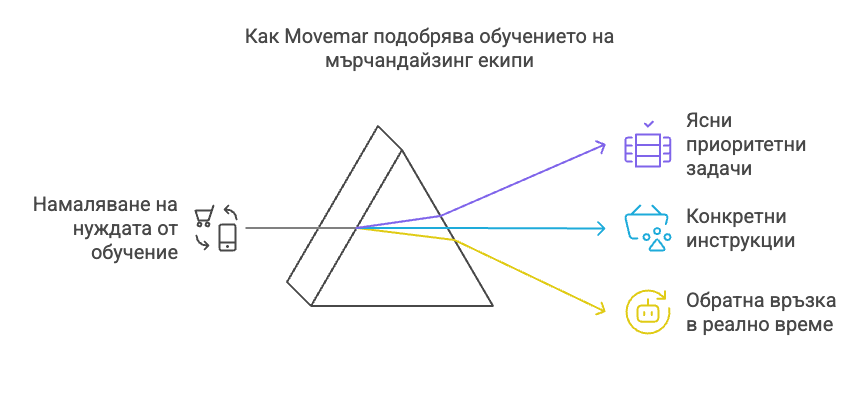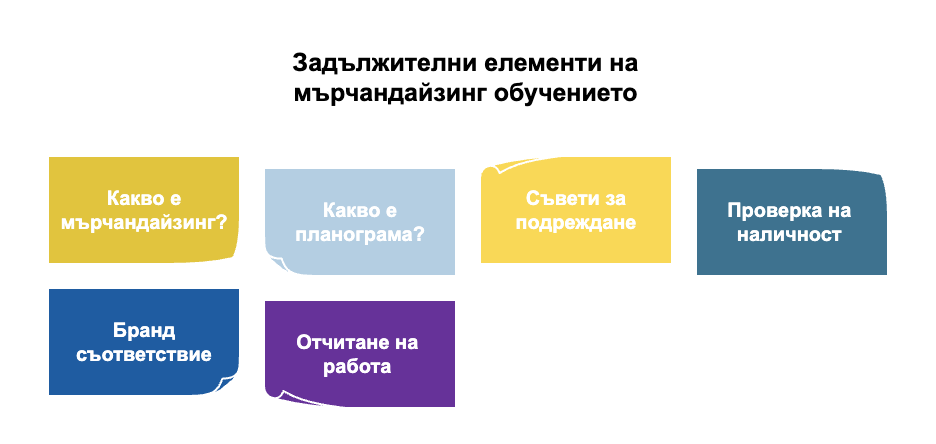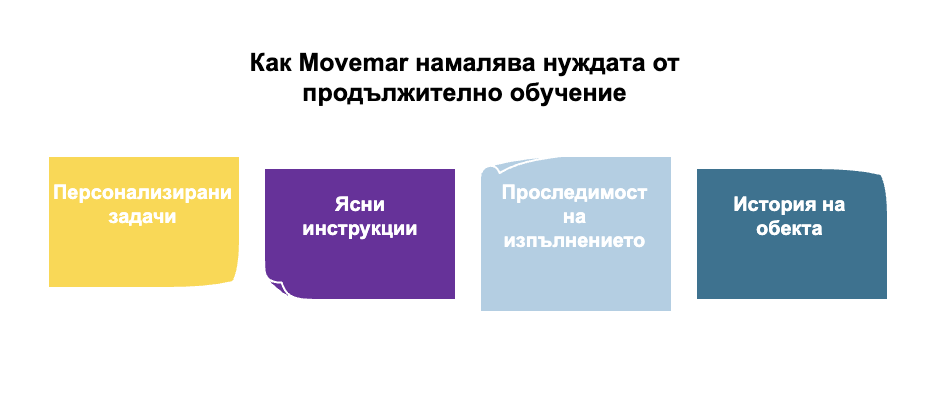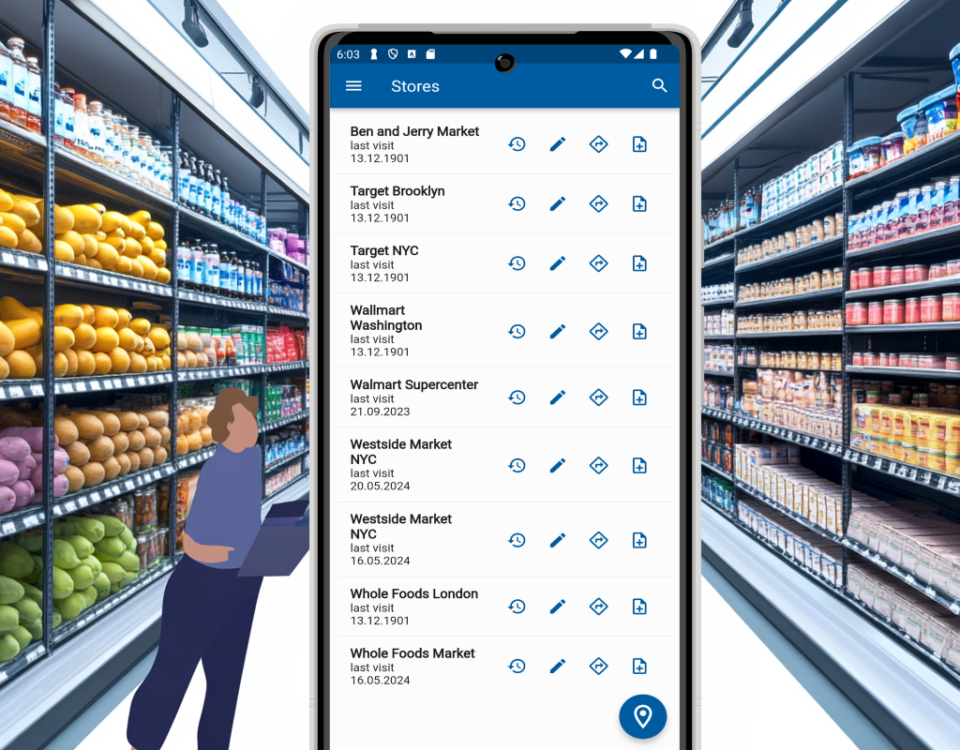
New functionality – Conditional questions (If this then that)
Merchandising training – how to build a well-prepared and effective team
Contents
Merchandising training that doesn’t stop, but no longer starts from scratch
For brands, distributors, and merchandising agencies that manage operations across dozens or hundreds of outlets, the field team is a critical link between strategy and execution. A well-trained merchandiser ensures products are in the right place, arranged to standard and visible to the customer.
In Bulgaria, however, there are no standardized training programs or certification for merchandising. Almost every company creates its own internal training model based on practice, shadowing and introductory meetings. This is often slow, costly and leads to uneven results across sites and regions.
This is where technology steps in, specifically platforms like Movemar, which drastically reduce the need for continuous training by providing the merchandiser:
- a clear timetable with prioritised tasks,
- specific instructions with planograms and photo examples,
- and real-time reporting and correction capability.

The result? Faster onboarding of new employees, lower training costs and higher efficiency in the facility – from week one.
In this article, we’ll share a practical training framework that you can implement right away, as well as show how one software tool can be the best “trainer” for your field teams.
What every new merchandiser should know before entering the site
Even when using a platform like Movemar to direct field tasks, every new addition to the team needs a basic understanding of their role, the standards and processes they should be following. Training doesn’t have to be an arduous process, but it does need to provide clarity on key topics so that the basics don’t go wrong.
Mandatory elements of induction training

- What is merchandising and why is it key to brand sales
- How to work with a planogram – visual arrangement, number of faces on the shelf, product position
- What is important in stacking – golden triangle, eye level, end racks
- How to check availability and expiry date (FIFO)
- What brand compliance means – POS materials, vision, promotional areas
- How to report work via Movemar – photos, comments, task status
➡️ This doesn’t have to be a 3-day course – everything can be explained in 1 working day, especially if the task structure is already set in Movemar.
The software eliminates the need for the new employee to search for answers to questions such as:
“Where do I start?”, “What exactly is being asked of me here?”, “What does a well-organized shelf look like?”
Movemar shows it all – through photo examples, instructions, checklists and tasks, arranged by priority.
How Movemar reduces the need for lengthy merchandising training
Training new merchandisers traditionally requires time, resources and the involvement of experienced colleagues or supervisors. But when using a platform like Movemar, much of this effort becomes redundant or severely curtailed. The software acts as a field navigator that automatically directs each employee to what’s really important – at the right place and time.
What makes Movemar different:
- Personalized tasks – Each employee sees only the tasks that are relevant to them, for that particular day and site. No confusion, no gaps.
- Clear instructions and planograms for each task – Photo examples, performance requirements, checklists. Even a new employee knows what is expected.
- Performance traceability – Managers see in real time if tasks are being completed, if there are deviations and where adjustments are needed.
- Site History – The new employee can see what the site looked like before, what it was positioned for, which products and campaigns were current.

The results for businesses:
- Faster introduction of new staff – by days, not weeks
- Less need for shadowing and supervision
- Lower training costs and less risk of errors
- Increased confidence of field teams because they always know what to do and how to do it
Movemar turns merchandising into a process with clearly defined steps and expectations – even for an employee with no previous experience.
What short and realistic merchandising training formats still make sense
While Movemar greatly reduces the need for lengthy introductions, a few short training formats are still valuable – especially at the beginning or when launching new campaigns. They don’t require a lot of time or resources, but they provide a confident start and build a baseline culture.
Three practical approaches:
- Introductory training (1 day)
Conducted by a supervisor or experienced merchandiser and covers:Polylang placeholder do not modify
- Short shadowing training (half day)
The new employee follows an experienced colleague into one or two sites, just to see the rhythm of work and interaction with the store.Polylang placeholder do not modify
- Onboarding with MovemarPolylang
placeholder do not modify
Continuous development without complex programs
After the initial training, the biggest challenge is maintaining the quality of performance over time. Most companies do not have the capacity for regular in-house academies or long training sessions. So the approach needs to be practical, flexible and embedded in the work itself.
How to achieve it:
- Use Movemar as a real-time training toolPolylang
placeholder do not modify
- Create short internal guidesPolylang
placeholder do not modify
- Share best practices from the fieldPolylang
placeholder do not modify
- Make use of the data in the systemPolylang
placeholder do not modify
Conclusion – The new reality in merchandising training
Training merchandising teams will always be important – because products don’t sell themselves, and good execution in the field is the foundation of any strong sales strategy. But with the help of software platforms such as Movemar, this process is no longer slow, unstructured and reliant solely on ‘practice with an experienced colleague’.
Today, companies can:
- Introduce new employees within days, not weeks
- Direct their teams to specific priorities and tasks on site
- Give clear feedback and maintain quality without the need for complex programs
- Reduce training costs and time without compromising results
In other words, training is no longer a burden, but a managed process with real results when supported by the right software.
👉 In the next article of the series we will build on the topic by showing exactly how such a platform works:
“Merchandising software – automation and data-driven decision making ” – expect a practical look at key features, benefits and real-world scenarios for brands and distributors in Bulgaria.
This publication is part of Merchandising – The Complete Guide to Modern Commerce, a comprehensive resource that covers all key aspects of merchandising: from strategies and techniques to standards, training and software solutions.
📖 Read the main article here.




